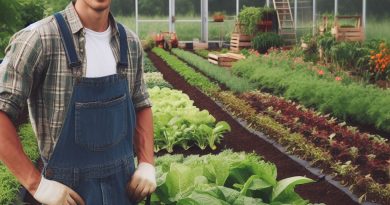Conservation Tillage: Saving Soil and Water
Last Updated on December 17, 2023
Introduction
Conservation tillage is a sustainable farming practice that minimizes soil disturbance during cultivation.
Definition of conservation tillage
Conservation tillage refers to the farming technique where minimal or no-till is used to preserve soil structure and nutrients.
Importance of soil and water conservation
Soil and water are vital resources for agriculture, and conservation tillage plays a crucial role in their preservation.
Conservation tillage helps prevent soil erosion by minimizing the exposure of bare soil to wind and water.
By reducing soil erosion, conservation tillage aids in maintaining soil fertility and organic matter content.
Conservation tillage also promotes water conservation by enhancing moisture retention in the soil.
This farming practice reduces the runoff of water and helps replenish groundwater supplies.
Additionally, conservation tillage minimizes the need for irrigation, saving water resources for other uses.
By preserving soil and water, conservation tillage supports sustainable agriculture and protects the environment.
This farming practice helps maintain biodiversity and reduces the use of chemicals, benefiting both plants and wildlife.
Moreover, conservation tillage reduces greenhouse gas emissions associated with conventional tillage methods.
In general, conservation tillage is an essential practice for soil and water conservation.
Its benefits include preventing soil erosion, enhancing water conservation, and supporting sustainable agriculture.
Benefits of Conservation Tillage
Reduces soil erosion
Conservation tillage prevents soil erosion by minimizing the disturbance of the soil surface.
- Decreases runoff, as plant residue covers the soil, reducing the impact of rainfall.
- Improves soil structure, creating a network of root channels that increase water infiltration.
- Protects the soil from wind erosion by maintaining crop residue on the surface.
Statistics show the detrimental effects of soil erosion:
- Approximately 24 billion tons of fertile soil are lost each year due to erosion.
- Topsoil erosion reduces crop productivity by 10% globally.
- The annual economic cost of soil erosion in the United States exceeds $44 billion.
Preserves soil structure
Conservation tillage plays a vital role in retaining soil nutrients and enhancing soil structure.
- By minimizing soil disturbance, conservation tillage prevents the loss of essential nutrients.
- Retaining crop residue on the surface improves organic matter content, creating a nutrient-rich soil environment.
- Improved soil structure promotes beneficial microbial activity, which further aids nutrient availability.
Examples of improved soil structure due to conservation tillage:
- Increased aggregation of soil particles, promoting better water and nutrient retention.
- Enhanced porosity allows for better root penetration and aeration, supporting healthy plant growth.
- Reduced compaction, resulting in improved drainage and reduced runoff.
Enhances water retention
Conservation tillage significantly improves the soil’s ability to retain water, benefiting both plants and the environment.
- The reduced soil disturbance allows for greater water infiltration and reduces water evaporation.
- Retained crop residue acts as a protective layer, preventing water loss through direct exposure to sunlight.
- Increased water retention capacity ensures a consistent water supply for crops during dry periods.
Benefits of improved water retention for crop growth:
- Increased plant resilience to drought stress, leading to higher crop yields.
- Reduced irrigation needs, conserving water resources and minimizing water pollution.
- Improved soil moisture levels promote healthy root development and nutrient uptake.
Read: Integrated Pest Management: Eco-Friendly Tactics

Types of Conservation Tillage
In the world of agriculture, conservation tillage has gained recognition for its ability to save soil and water.
This method of farming involves reducing or eliminating soil disturbance, which helps to maintain soil structure and prevent erosion.
There are three main types of conservation tillage techniques: no-till farming, reduced tillage, and strip tillage.
No-till farming
No-till farming, also known as zero tillage or direct seeding, is a technique that eliminates the conventional plowing or tilling of soil before planting.
Instead, seeds are sown directly into untilled soil.
The advantages of implementing no-till farming are manifold.
Firstly, it helps to conserve soil moisture by leaving crop residue on the surface, thus reducing evaporation.
This is particularly beneficial in dry regions where water scarcity is a concern.
Secondly, no-till farming reduces soil erosion.
By keeping the soil undisturbed, it maintains the protective layer of organic matter, making it harder for wind and water to carry away valuable topsoil.
Thirdly, this technique promotes the growth of beneficial soil organisms.
When the soil is left undisturbed, earthworms, bacteria, fungi, and other microorganisms thrive, enhancing soil fertility and nutrient cycling.
However, implementing no-till farming does come with its challenges. One of the main challenges is managing weeds effectively.
With minimal soil disturbance, weed control requires alternative methods such as strategic herbicide applications or crop rotation.
Another challenge is dealing with crop residue.
Although leaving crop residue on the surface provides multiple benefits, it can also create obstacles for planting equipment and hinder crop emergence in certain situations.
Reduced tillage
Reduced tillage, also known as minimum tillage or conservation plowing, involves reducing the frequency and intensity of soil disturbance compared to traditional tillage practices.
There are variations within reduced tillage techniques, such as shallow tillage and chisel plowing.
Shallow tillage involves minimal soil disturbance, typically not exceeding a depth of 6 inches.
Chisel plowing, on the other hand, utilizes a specialized implement with sharp, narrow points to disturb the soil and break up compaction.
When compared to no-till farming, reduced tillage offers a middle ground that provides some of the benefits of conservation tillage while still allowing for limited soil disturbance.
It can help conserve soil moisture, reduce erosion, and improve soil health, although to a lesser extent than no-till farming.
Strip tillage
Strip tillage combines elements of both no-till farming and full-width tillage.
It involves tilling narrow strips of soil, typically where crop rows will be planted while leaving the rest of the field untilled.
This approach offers benefits for specific crops and soil types.
By creating tilled strips, it provides a suitable seedbed for planting, ensuring good seed-to-soil contact and aiding germination.
At the same time, the untilled strips between the rows help retain moisture, reduce erosion, and maintain soil structure.
Strip tillage is particularly popular for row crops such as corn, soybeans, and sugar beets.
It allows farmers to manage residue and fertilizers more efficiently, while also reducing fuel consumption compared to full-width tillage.
In essence, this tillage technique play a vital role in preserving soil and water resources.
Whether it’s through no-till farming, reduced tillage, or strip tillage, farmers can adopt methods that suit their specific needs and circumstances.
By embracing these practices, we can ensure the long-term sustainability of agriculture while protecting our environment for future generations.
Read: Cover Crops: Protecting and Nourishing Soil
Challenges and Best Practices of Conservation Tillage
Weed Management
- Controlling weeds in this tillage systems poses unique challenges.
- Weeds can compete with crops for resources and reduce overall crop yield.
- Efficient weed management techniques and practices are crucial to ensuring successful conservation tillage.
- Applying herbicides with specific modes of action can target resistant weeds effectively.
- Crop rotation and cover cropping help suppress weed growth and improve soil health.
Soil Compaction
- This practice, if not implemented carefully, can lead to soil compaction issues.
- Decreased tillage disrupts the natural processes that alleviate soil compaction.
- By reducing soil disturbance and using appropriate machinery, compaction can be minimized.
- Improving soil structure through cover cropping and adding organic matter helps prevent compaction.
- Proper soil moisture levels and avoiding tillage when soils are too wet can also prevent compaction.
Nutrient Management
- It may pose challenges in nutrient availability for crops.
- Reduced tillage can slow down decomposition of organic matter and release of nutrients.
- Regular soil testing and monitoring are crucial to understand nutrient levels and make necessary adjustments.
- Applying targeted and timely fertilizers ensures crop productivity and meets nutrient requirements.
- Utilizing precision application technologies can maximize nutrient use efficiency in conservation tillage.
In short, while conservation tillage offers numerous benefits in terms of soil and water conservation, several challenges need to be addressed.
Weed management requires adopting efficient techniques such as herbicide application, crop rotation, and cover cropping.
Soil compaction can be minimized through proper implementation of conservation tillage practices, such as reducing soil disturbance and improving soil structure.
Nutrient availability challenges can be overcome by regular soil testing, targeted fertilization, and precision application technologies.
By understanding and implementing best practices, farmers can ensure the success of conservation tillage systems.
Read: Natural Pest Control: Chemical-Free Farming
Success Stories and Case Studies
Tn Ohio, the Marion Soil and Water Conservation District initiated a program called “The Strip-Till Advantage,” which encourages farmers to adopt conservation tillage practices.
One farmer, John Smith, switched from conventional tillage to strip-till and saw significant improvements in soil health.
Smith noticed that his fields retained more moisture, resulting in increased crop yields.
Another success story comes from Iowa, where the Iowa Soybean Association’s On-Farm Network helps farmers implement conservation practices.
Tom Johnson, a soybean farmer, started using no-till and cover crops on his farm.
Johnson saw a decrease in soil erosion and an increase in organic matter content, leading to better water infiltration.
In Minnesota, the Gunderson family has been practicing no-till for over a decade.
They have observed that their soil is less compacted, allowing roots to penetrate deeper for better nutrient uptake.
The Gundersons also noticed improved water quality in nearby streams due to reduced sedimentation.
A case study conducted in Kansas showed the positive impact of conservation tillage on water conservation.
The study found that using no-till and cover crops reduced soil erosion and nutrient runoff, improving water quality in rivers and lakes.
Wyoming farmer, Sarah Thompson, started practicing conservation tillage methods on her ranch.
Thompson noticed a decrease in the amount of water required for irrigation and an increase in the fertility of her soil.
The success stories and case studies illustrate the benefits of conservation tillage on soil and water conservation.
Farmers who adopted these practices experienced higher crop yields, improved soil health, and reduced water usage.
Conservation tillage helps retain moisture in the soil, mitigating the risk of drought and water scarcity.
By reducing soil erosion, conservation tillage also prevents sedimentation and nutrient runoff into water bodies.
Implementation of conservation tillage practices leads to improved water quality and helps protect aquatic ecosystems.
These success stories demonstrate that conservation tillage is a sustainable and effective approach to soil and water conservation.
Farmers can make a significant positive impact on the environment while maintaining profitable agriculture operations.
Conservation tillage practices should be encouraged and supported by government policies and incentives.
Education and outreach programs can play a crucial role in raising awareness and promoting the adoption of this practice.
Farmers should have access to technical assistance and resources to successfully transition to conservation tillage methods.
Collaboration between farmers, researchers, and conservation organizations can further advance the implementation of conservation tillage.
Read: Composting: Turning Waste into Farming Gold
Conclusion
In closing, conservation tillage plays a crucial role in saving soil and water resources.
It promotes sustainable agriculture by reducing erosion, improving soil health, and conserving water.
By adopting this practices, farmers can benefit from increased crop yields, reduced labor and fuel costs, and improved water quality.
This type of tillage does not only protect the environment but also helps to mitigate climate change by sequestering carbon in the soil.
It is essential for farmers to understand the importance of this practice and actively adopt these practices on their farms.
Government agencies and agricultural organizations should provide support, education, and incentives to encourage farmers to implement this tillage methods.
By ensuring the widespread adoption of conservation tillage, we can contribute to the long-term sustainability of our agricultural systems and safeguard our precious soil and water resources for future generations.


